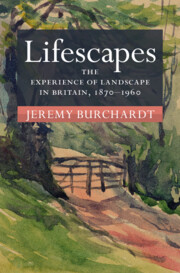Book contents
- Lifescapes
- Modern British Histories
- Lifescapes
- Copyright page
- Dedication
- Contents
- Figures
- A Note on the Subtitle
- Preface
- Introduction
- 1 Diaries, Life Writing and Popular Ruralism
- Adherers
- Withdrawers
- Restorers
- Explorers
- Conclusion Towards a Deep History of Landscape
- Afterword The Politics of Landscape Experience
- Select Bibliography
- Index
Conclusion - Towards a Deep History of Landscape
Published online by Cambridge University Press: 20 April 2023
- Lifescapes
- Modern British Histories
- Lifescapes
- Copyright page
- Dedication
- Contents
- Figures
- A Note on the Subtitle
- Preface
- Introduction
- 1 Diaries, Life Writing and Popular Ruralism
- Adherers
- Withdrawers
- Restorers
- Explorers
- Conclusion Towards a Deep History of Landscape
- Afterword The Politics of Landscape Experience
- Select Bibliography
- Index
Summary
Each of the individuals considered in the book had a different relationship to landscape. This reflected the varying circumstances, situations, events and influences (including cultural influences) that shaped their lives. Despite these contrasts, it is possible to identify four broad groupings. Adherers like Hallam and Cresswell were motivated by a passionate need to maintain their connection with a cherished past. Rural landscapes associated with this past served as a guarantee of its continuity. Withdrawers such as Dickinson and Spear Smith sought to escape from an oppressive present, be that family tensions and social prejudice as in Dickinson’s case, or Spear Smith’s vocational difficulties. Restorers turned to the countryside as a place in which they could reconnect with and re-energize belief systems that had been challenged, disrupted or pushed aside by personal exigencies or professional demands – medical practice for Johnston and probation work for Bissell. Finally, Explorers like Barmes and Catley valued rural landscapes above all as sites of self-discovery and self-development.
Keywords
- Type
- Chapter
- Information
- LifescapesThe Experience of Landscape in Britain, 1870–1960, pp. 410 - 456Publisher: Cambridge University PressPrint publication year: 2023



